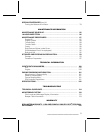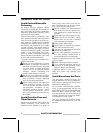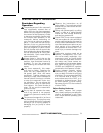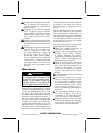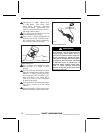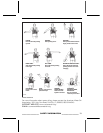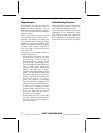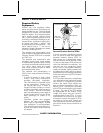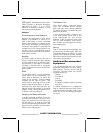
SPECIAL SAFETY MESSAGES
At least one passenger should be
able to o perate the wa tercraft i n
case the operator is unexp ec te dly
unable to do so.
Operatio n of this PWC by a person
under 16 years of age or a person
with a disability that impairs vision,
reaction time, judgm ent, or opera-
tion of the controls is NOT recom-
mended.
Always use the safety lanyard when
operating t he watercraft a nd ensure
that all passengers are familiar with
its use.
Ensure tha t any opera tor and all pas-
sengers kn ow how to sw im and
how to re-board the PWC from
thewater. Boardingindeepwa-
ter can be strenuous. Practice in
chest-deep wa ter before op erat-
ing or embarking your watercraft
in deep wa ter. If a pa s senger does
not kn ow how to swim, ensure that
passenger wea rs a PFD a t all times
and tak e extra precautio ns when
boating.
Water Spo rts
WARNING
Avoid personal injury! Your PWC
is not designed for and should not
be used for pulling parasails, kites,
gliders, or any device which can
become airborne. Use watercraft
only for appropriate water sports.
Water skiing, wakeboardin g, or riding
a towed, i nflatable appara
tus are some
of the more popular water sports. Tak-
ing part in any water sport req uires
increased safety awaren
ess by the par-
ticipant a nd the watercraft operator. If
you have never pulled someone be-
hind your PWC befor
e, it is a good idea
to spend some hours as an observer,
working with and learning from an ex-
perienced drive
r. It is also important to
be aware of the sk ill and experience of
the person being pulled. Alw a y s have
a second person on board to observe
the person in the w a ter so the driver
can concentrate on operating the wa-
tercraft.
Both the operator and observer shoul d
monitor the location of the towrope
when participating in watersports. A
slack tow rope can become entangled
with person(s) or objects on the PW C
or in the water, particularly when mak-
ing a tight turn or circling, and cause
serious personal in jury.
Everyone participating in a water sport
should observe thes e guidel ines:
Allow only capable sw immers to
take part in any water sport.
Always wear an approved personal
flotation device (PFD). We aring
a properly d es igned PFD helps a
stunned or unc ons c ious person stay
afloat. A Type-IV water-ski vest is an
approved and practical PFD.
Have a sec ond pe rson aboa rd to
observe the p erso n being towed
and inform the driver about the par-
ticipant's hand signals. Th e driver
must give full attention to operat-
ing the watercraft and the waters
ahead.
Be considerate t o others you share
the water with.
Do not tow a person in any water
sport on a short tow rope such that
the person inhales exhaust fumes
in conc entra tion. Inha lation of con-
centrated exhaust fumes, which
contain carbon m onoxide, c a n re-
sult in CO poisoning, personal injury
and death.
Give immedi ate attention to a per-
son who has fallen. He or she is
vulnerable in the water alo ne and
may not be seen by other boaters.
Approach a person in the wate r from
the lee side (opposite th e direction
of the wind). Turn off the motor be-
fore coming close to the person.
________
SAFETY INFOR MATION
________
11





